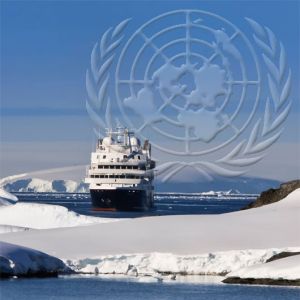UNCLOS
 (Photo: Arctic Portal)Number of international treaties apply to the Arctic region, in particular United Nations Convention on Law of the Sea which provides rules concerning maritime boundaries, claims to an outer continental shelf, sovereign rights over resources and the protection of the marine environment.
(Photo: Arctic Portal)Number of international treaties apply to the Arctic region, in particular United Nations Convention on Law of the Sea which provides rules concerning maritime boundaries, claims to an outer continental shelf, sovereign rights over resources and the protection of the marine environment.
In a way, UNCLOS as the longest treaty in history of United Nations, creates significant for the Arctic, set of rules which recognizes three different cathegories of states, i.e. coastal, port and flag. All the Arctic states are parties to the Convention, except for the United States.
Jurisdiction and sovereignty of coastal states varies, depanding on the maritime zone described in the Convention. Full sovereignty and maximum jurisdiction is given to the coastal state in its internal waters, however the right of innocent passage for foreign vessels is recognized in case of historic regime of shared sovereignty over the area.
Within the extent of 12 nautical miles the coastal states claim its territorial sea. They enjoy full sovereignty over this area but their jurisdiction is limited by the foreign´s ships rights to innocent passage as long as it is not prejudicial to the state´s good order, pease or security.It is an on going issue for coastal states to maximize their territorial sea zone in order to better protection of environment and natural resources. Currently five Arctic states claim their maximum, 12 mile territorial sea zone, while Denmark streaches one only up to 3 nautical miles.
In adjacent to territorial sea, streached up to 24nautical miles contiguous zone, coastal states can exersise their juristiction over foreign vessels to prevent against violation of customs, fiscal, immigration and sanitary laws. However it is 200 nautical mile exclusive economic zone where those states are given rights to adopt pollution prevention regulations. Although, an acctual arrest and detention are only allowed if passing ship causes the major damage to the coast, coastal state, marine environment and its resources. Six Arctic states claim 200 nautical miles EEZ, additionally Norway claims its zone around Svalbard and Jan Mayen.
 An illustration showing the territorial sea, the contiguous zone, the exclusive economic zone and the international waters. Click to enlarge. (Made by Arctic Portal).UNCLOS states that coastal countries have exclusive sovereign rights to explore their natural resources, mineral and other non - living resources, in their continental shelf which streaches up to 200 nautical miles from the coast baseline and comprises seabed and suboil of the submarine areas beyond the territorial sea.
An illustration showing the territorial sea, the contiguous zone, the exclusive economic zone and the international waters. Click to enlarge. (Made by Arctic Portal).UNCLOS states that coastal countries have exclusive sovereign rights to explore their natural resources, mineral and other non - living resources, in their continental shelf which streaches up to 200 nautical miles from the coast baseline and comprises seabed and suboil of the submarine areas beyond the territorial sea.
The Convention claims the flag state to have jurisdicion over its ship on the high seas, allowing the exeptions when other international agreements provide otherwise. Flag state makes sure that the ship is complaint with international standards for safty and security at sea, technical, administrative and legal rules.
The authority given to port states concerns the control of conditions under which the foreign ships enters into their ports. It can be easly stated that the port state can impose and enforce any power with regards to the foreign ship which is voluntary in its port. It may decide to investigate or even prosecute the foreign ships for pollution and other violations of state´s law.
UNCLOS defines the use of international straits as the right to transit passage. States which have the boarder with the strait, cannot suspend passage of foreign ships and may only adopt ship - source pollution laws aplicable to foreign ships if in accord with international standards.
Source: United Nations Convention on the Law of the Sea







